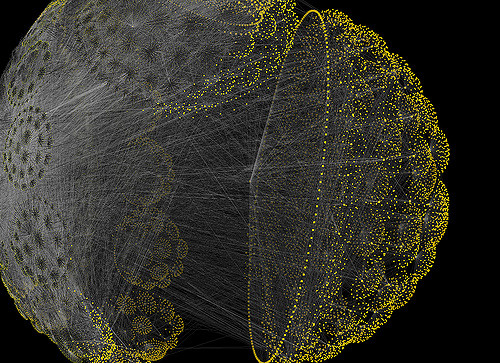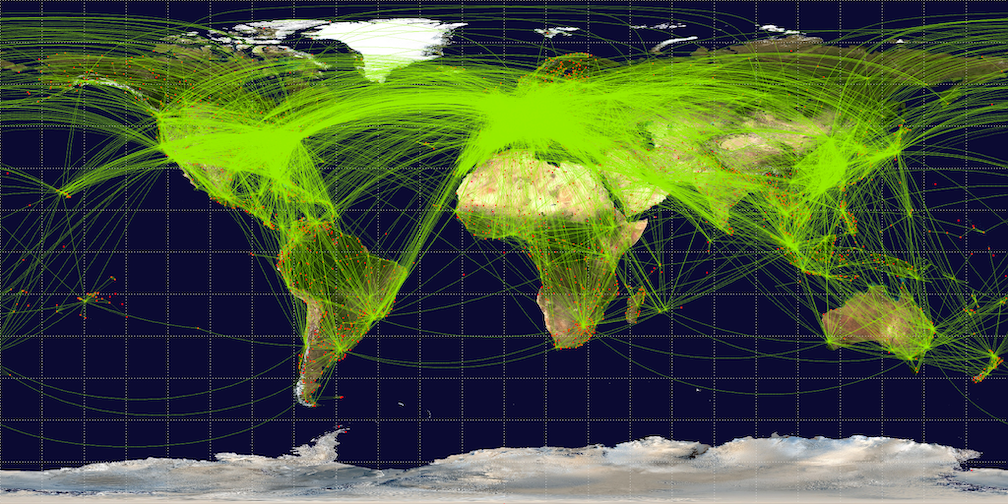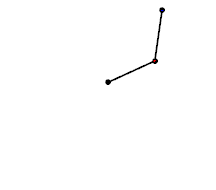cas/taxonomy/field.php (field)

Relational Geography
If geography is not composed of places, but rather places are the result of relations, then how can an understanding of complex flows and network dynamics help us unravel the nature of place?
Relational Geographers examine how particular places are constituted by forces and flows that operate at a distance. They recognize that flows of energy, people, resources and materials are what activate place, and focus their attention upon understanding the nature of these flows.
Networked Space:
Which two cities are closer together - London and Blackpool or London and New York? From a strictly metric geographic sense, we would answer that London and Blackpool are closer, and for a long time that would be how geographers would respond. But in recent decades geographers have become increasingly interested in how places are constituted not so much according to fixed, metric qualities, but in terms of how different kinds of flows tie spaces together. These spaces might be quite far from one another in a geographic sense, but quite close together in terms of how they relate: hence relational geography.
Looking at these three cities from a relational perspective, we would consider the kinds of flows that move between them - flows that might be constituted of people, ideas, money, resources, etc. From this perspective, we could reasonably argue that London and New York have far greater intensities of flows, drawing them closer together than the Blackpool counterpart situated in the the UK.
Relational geography is thus interested both in the kinds of Networks that exist between places, as well as the Driving Flows that these networks carry. Rather than seeing places as being primary and the relations between places being as a secondary outcome of these primary "things", relational geography flips this relationship on its head: arguing that we need to look at the relational flows first with particular places then being constituted by the nature of how these flows come to be grounded or moored in particular settings (see for example the work of John Urry). It employs Network theory to help think about how the dynamics of agent interactions - the flows moving between them - affect the performance of complex geographical systems.
Complexity and Relational Geography
Given these interests, it is stands to reason that geographers interested in understanding how to think through this orientation would notice similarities to complexity theory. Relational geographers, thus began to draw inspiration from complexity dynamics, particularly as it pertains to such phenomena as Emergence, Non-Linearity, and Driving Flows. Relational geographers are not particularly engaged with the nature of self-similar or nested orders in complex systems, and if focused on individual agents, then these are most often thought of not at the scale of humans in cities, but as cities themselves as agents in a global network.
Relational Geography, attunes in particular to how network structure may have an effect on the kinds of urbanization patterns that emerge; how present day patterns of habitation are not necessarily 'natural' outgrowths of previous patterns in a clear, logical chain, but instead how History Matters and Contingency plays a key role. They may employ the language of complexity, using terms like Bifurcations to try to capture the contingent, non-linear dynamics at play.
Thus, what makes a "world class" city, vs a local city, and what are the driving forces at play that weave this city into global versus local networks of influence. How can cities who may be at the fringes move to steer more driving flows of resources and people into their sphere or influence? What geographical regions are left behind? For example, how does the location of a particular rail line, and its stations, change the dynamics of proximity in ways that may privilege certain regions, while marginalizing others that are left with poorer access to these flows of mobility?
These kinds of questions slide up alongside many of the terms and concepts used in complexity thinking.

map of global airline routes - Wikimedia commons
Back to Complexity & Urbanism
Back to Navigating Complexity
Photo Credit and Caption: Huge Social Network Visualization with Walrus 6, by Einer von Denen
Cite this page:
Wohl, S. (2022, 13 June). Relational Geography. Retrieved from https://kapalicarsi.wittmeyer.io/taxonomy/relational-geography
Relational Geography was updated June 13th, 2022.
Nothing over here yet
This is the feed, a series of related links and resources. Add a link to the feed →
Nothing in the feed...yet.
This is a list of People that Relational Geography is related to.
Relational Geography | Flows
This is a default subtitle for this page. Learn more →Relational Geography & Flows
This is a default subtitle for this page. Learn more →Relational Geography
This is a default subtitle for this page. Learn more →Relational Geography
This is a default subtitle for this page. Learn more →This is a list of Terms that Relational Geography is related to.
Certain ideas in Urbanism that highlights flows and relations in space, rather than particular places.
This is relevant to the field of Relational Geography
Learn more →The idea that many possible states or historical trajectories could have equally unfolded
Beyond its day-to-day usage, this term used in now employed in the social sciences to highlight the Path Dependency exhibited in many social systems. This is seen to contrast with prior conceptions like "the march of history", which imply a clear causal structure. By speaking about the work as something contingent, it also begs the question of what other "worlds" might have just as equally manifested, had things been slightly different.
Similar ideas are captured in the ideas of Non-Linearity, {{sensitivity-to-initial-conditions}}, History Matters.
Pictured below: the contingent trajectory of the double pendulum:

Learn more →
This is a list of Urban Fields that Relational Geography is related to.
This is a list of Key Concepts that Relational Geography is related to.
Open & dissipative systems, while 'bounded' by internal dynamics, nonetheless exchange energy with their external environment.
A system is considered to be open and dissipative when energy or inputs can be absorbed into the system, and 'waste' discharged. Here, system inputs like heat, energy, food, etc., can traverse the open boundaries of the system and ‘drive’ it towards order: seemingly in violation of the second law of thermodynamics.
Learn more →Network theory allows us think about how the dynamics of agent interactions in a complex system can affect the performance of that system.
Network theory is a huge topic in and of itself, and can be looked at on its own, or in relation to complex systems. There are various formal, mathematical ways of studying networks, as well as looser, more fluid ways of understanding how networks can serve as a structuring mechanism. Learn more →
Navigating Complexity © 2015-2025 Sharon Wohl, all rights reserved. Developed by Sean Wittmeyer
Sign In (SSO) | Sign In
Related (this page): Non-Linearity (26), Driving Flows (25), Unfolding Interactions (110), Tipping Points (218), Path Dependency (93), Open / Dissipative (84), Networks (75), Fluidity/Mobility (111),
Section: fields
Non-Linearity Related (same section): Urban Modeling (11, fields), Resilient Urbanism (14, fields), Relational Geography (19, fields), Landscape Urbanism (15, fields), Evolutionary Geography (12, fields), Communicative Planning (18, fields), Assemblage Geography (20, fields), Related (all): Tipping Points (218, concepts), Path Dependency (93, concepts), Far From Equilibrium (212, concepts),
Nested Orders Related (same section): Urban Modeling (11, fields), Urban Informalities (16, fields), Resilient Urbanism (14, fields), Related (all): Self-Organized Criticality (64, concepts), Scale-Free (217, concepts), Power Laws (66, concepts),
Emergence Related (same section): Urban Modeling (11, fields), Urban Informalities (16, fields), Urban Datascapes (28, fields), Incremental Urbanism (13, fields), Evolutionary Geography (12, fields), Communicative Planning (18, fields), Assemblage Geography (20, fields), Related (all): Self-Organization (214, concepts), Fitness (59, concepts), Attractor States (72, concepts),
Driving Flows Related (same section): Urban Datascapes (28, fields), Tactical Urbanism (17, fields), Relational Geography (19, fields), Parametric Urbanism (10, fields), Landscape Urbanism (15, fields), Evolutionary Geography (12, fields), Communicative Planning (18, fields), Assemblage Geography (20, fields), Related (all): Open / Dissipative (84, concepts), Networks (75, concepts), Information (73, concepts),
Bottom-up Agents Related (same section): Urban Modeling (11, fields), Urban Informalities (16, fields), Resilient Urbanism (14, fields), Parametric Urbanism (10, fields), Incremental Urbanism (13, fields), Evolutionary Geography (12, fields), Communicative Planning (18, fields), Related (all): Rules (213, concepts), Iterations (56, concepts),
Adaptive Capacity Related (same section): Urban Modeling (11, fields), Urban Informalities (16, fields), Tactical Urbanism (17, fields), Parametric Urbanism (10, fields), Landscape Urbanism (15, fields), Incremental Urbanism (13, fields), Evolutionary Geography (12, fields), Related (all): Feedback (88, concepts), Degrees of Freedom (78, concepts),
